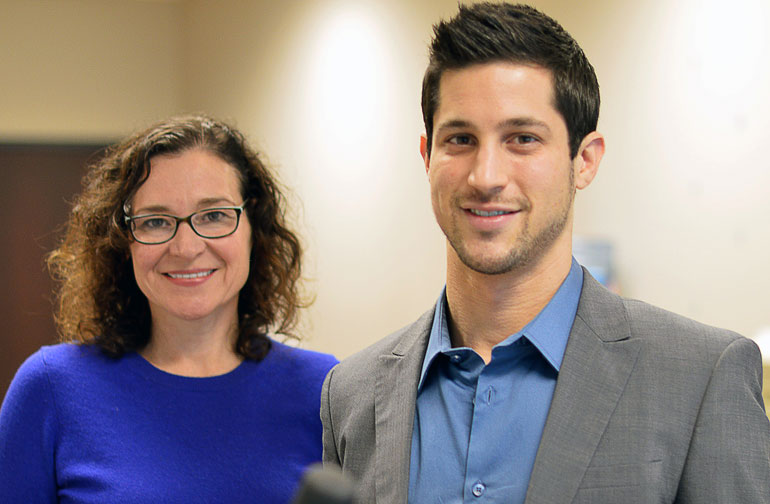
UBC professor Kathleen Martin Ginis (left) and PhD candidate Matthew Stork.
Listening to music may make it easier for people to adopt short duration exercise regimens that could help them stay in shape, according to researchers at UBC’s Okanagan campus.
In a recently published study, researchers Kathleen Martin Ginis and Matthew Stork studied the attitudes of moderate exercisers towards high-intensity interval training (HIIT), which they hadn’t been exposed to before. The pair found that the first-timers not only had positive attitudes toward HIIT, but that participants also reported feeling more positive about the exercise regimen if they listened to music while they exercised.
HIIT is a time-efficient exercise strategy that sees people engage in short periods of intense anaerobic exercise separated by less-intense recovery periods. The exercise is distinct from more traditional long-duration aerobic exercise, such as jogging continuously for 50 minutes.
“There has been a lot of discussion in the exercise and public policy worlds about how we can get people off the couch and meeting their minimum exercise requirements,” says Martin Ginis, professor of health and exercise sciences at UBC. “The use of HIIT may be a viable option to combat inactivity, but there is a concern that people may find HIIT unpleasant, deterring future participation.”
To their surprise, the researchers found that participants who engaged in multiple HIIT sessions not only enjoyed the exercise, but they maintained positive attitudes about engaging in HIIT again in the future.
“Newer research has established that as little as 10 minutes of intense HIIT, three times per week can elicit meaningful heath benefits,” says Stork, a PhD candidate at UBC’s Okanagan campus. “For busy people who may be reluctant to try HIIT for the first time, this research tells us that they can actually enjoy it, and they may be more likely to participate in HIIT again if they try it with music.”
“Our research aims to learn more about people’s perceptions towards HIIT and ultimately determine if people can adhere to these types of exercises in the long term,” says Stork. “With the introduction of HIIT exercise, people may not necessarily require the dreaded 150-minute weekly total.”
According to traditional exercise recommendations from the Canadian Society for Exercise Physiology, adults aged 18 to 64 should accumulate a minimum of 150 minutes of moderate-to-vigorous exercise per week.
Martin Ginis and Stork’s study was recently published in the Journal of Sport Sciences. To find out more, visit: www.tandfonline.com/doi/full/10.1080/02640414.2016.1242764
—30—